Summary on deep learning framework --- Theano && Lasagne
Summary on deep learning framework --- Theano && Lasagne
2017-03-23
1. theano.function
output = input ** 2
f = theano.function([input], output)
print(f(3))
>> the output is: 3^2 = 9.

2. verbose = 1 or 0, does it have any difference ?
some deep learning framework such as torch or theano, use this flag to control whether shown some training information on the terminal.
such as: hist = Deep_Q_Network.fit(X_train, y_train, batch_size=batch_size, nb_epoch=1, verbose=1)
It will display on the terminal: loss: ~~~
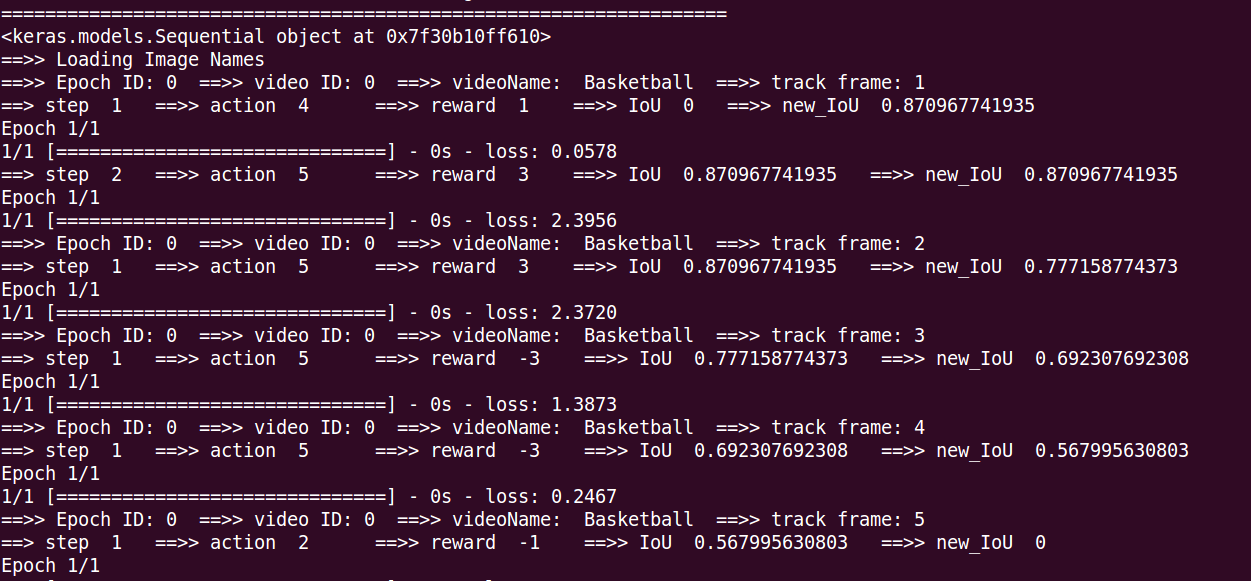
3. how to use specific GPU with Theano framework ?
-->> device=gpu{0, 1, ...}
the answer from: http://www.cnblogs.com/shouhuxianjian/p/4590224.html
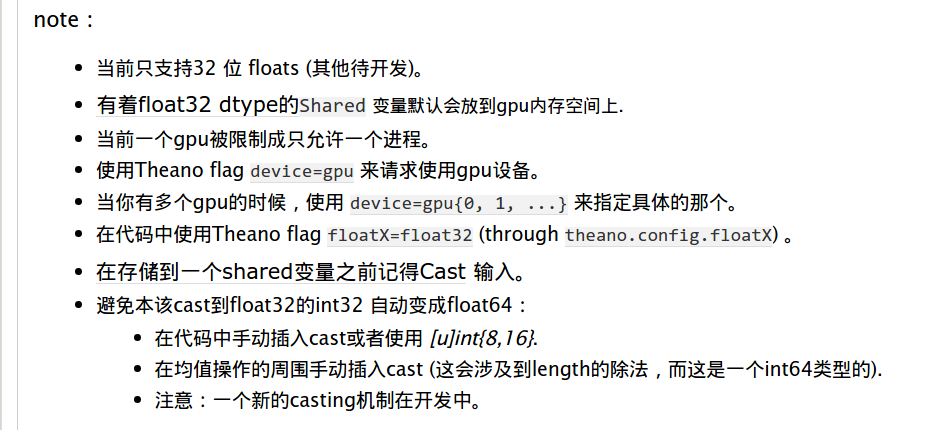
4. ValueError: GpuJoin: Wrong inputs for input 2 related to inputs 0.!
0%| | 0/301 [00:00<?, ?it/s]
Traceback (most recent call last):
File "wangxiao-02-train.py", line 187, in <module>
train()
File "wangxiao-02-train.py", line 171, in train
salgan_batch_iterator(model, train_data, None)
File "wangxiao-02-train.py", line 108, in salgan_batch_iterator
G_obj, D_obj, G_cost = model.D_trainFunction(batch_input,batch_output,batch_patch) #add batch_patch ???
File "/usr/local/lib/python2.7/dist-packages/theano/compile/function_module.py", line 871, in __call__
storage_map=getattr(self.fn, 'storage_map', None))
File "/usr/local/lib/python2.7/dist-packages/theano/gof/link.py", line 314, in raise_with_op
reraise(exc_type, exc_value, exc_trace)
File "/usr/local/lib/python2.7/dist-packages/theano/compile/function_module.py", line 859, in __call__
outputs = self.fn()
ValueError: GpuJoin: Wrong inputs for input 2 related to inputs 0.!
Apply node that caused the error: GpuJoin(TensorConstant{1}, GpuElemwise{Composite{scalar_sigmoid((i0 + i1))},no_inplace}.0, GpuFromHost.0)
Toposort index: 955
Inputs types: [TensorType(int8, scalar), CudaNdarrayType(float32, (False, True, False, False)), CudaNdarrayType(float32, 4D)]
Inputs shapes: [(), (32, 1, 192, 256), (32, 3, 224, 224)]
Inputs strides: [(), (49152, 0, 256, 1), (150528, 50176, 224, 1)]
Inputs values: [array(1, dtype=int8), 'not shown', 'not shown']
Outputs clients: [[GpuContiguous(GpuJoin.0)]]
HINT: Re-running with most Theano optimization disabled could give you a back-trace of when this node was created. This can be done with by setting the Theano flag 'optimizer=fast_compile'. If that does not work, Theano optimizations can be disabled with 'optimizer=None'.
HINT: Use the Theano flag 'exception_verbosity=high' for a debugprint and storage map footprint of this apply node.
what's going on ???
==>> Because I input wrong image size: as shown in blue ! (32, 1, 192, 256), (32, 3, 224, 224)
5. Error when tring to find the memory information on the GPU: an illegal memory access was encountered
0%| | 0/301 [00:00<?, ?it/s]Error when tring to find the memory information on the GPU: an illegal memory access was encountered
Error freeing device pointer 0x10372a00000 (an illegal memory access was encountered). Driver report 0 bytes free and 0 bytes total
CudaNdarray_uninit: error freeing self->devdata. (self=0x7f19d0544830, self->devata=0x10372a00000)
Error when trying to find the memory information on the GPU: an illegal memory access was encountered
Error allocating 422125568 bytes of device memory (an illegal memory access was encountered). Driver report 0 bytes free and 0 bytes total
Segmentation fault
==>>
6. some explnations about Jacobian matrix, Hessian matrix :
from: http://blog.csdn.net/lanchunhui/article/details/50234117
7. some basic tutorials from theano Document v0.9:
(1). basic functin definition:
>> import numpy as np
>> import theano.tensor as T
>> from theano import function
>> x = T.dscalar('x') -- double style the type we assign to “0-dimensional arrays (scalar) of doubles (d)”.
>> y = T.dscalar('y')
>> z = x + y
>> f = function([x, y], z)
when test, just input f(2, 3), then it will return z = 2+3 = array(5.0). We can also use the pp function to pretty-print out the computation associdated to z.
==>> print(pp(z)) ==>> (x+y).
Also, we can add two matrices: x = T.dmatrix('x')

(2). Derivatives in Theano
<1>. Computing Gradients: using T.grad
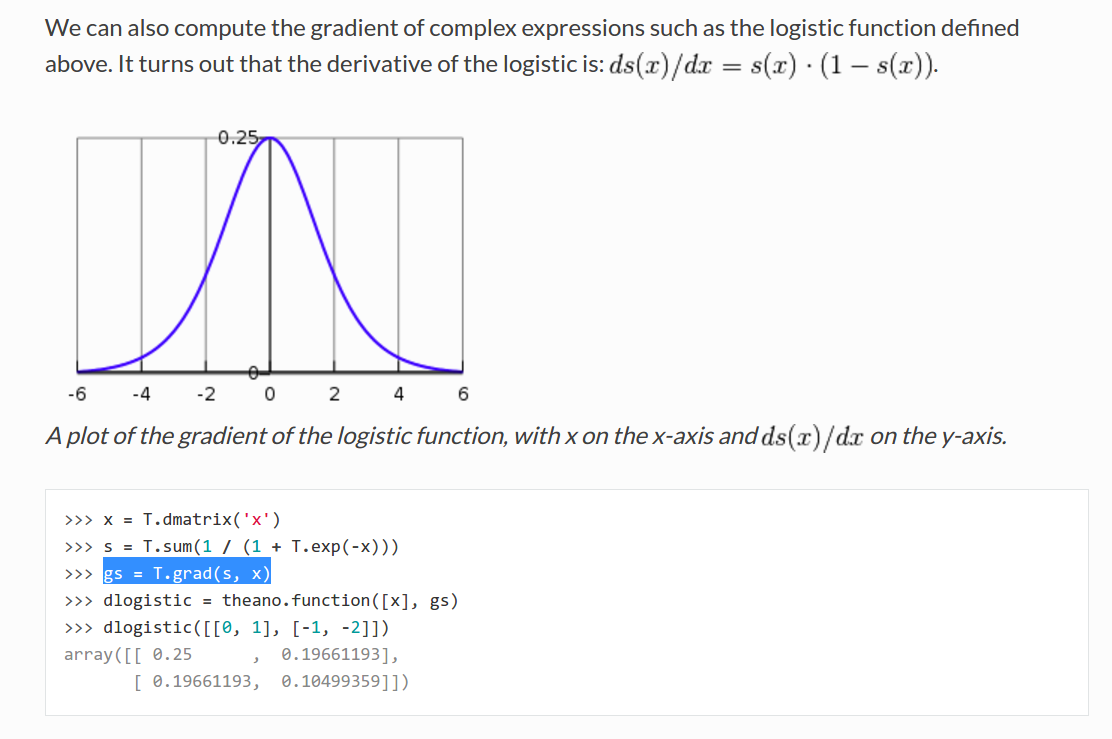
<2>. Computing the Jacobian
this blog provided us a good tutorial about this definiton: http://blog.csdn.net/lanchunhui/article/details/50234117
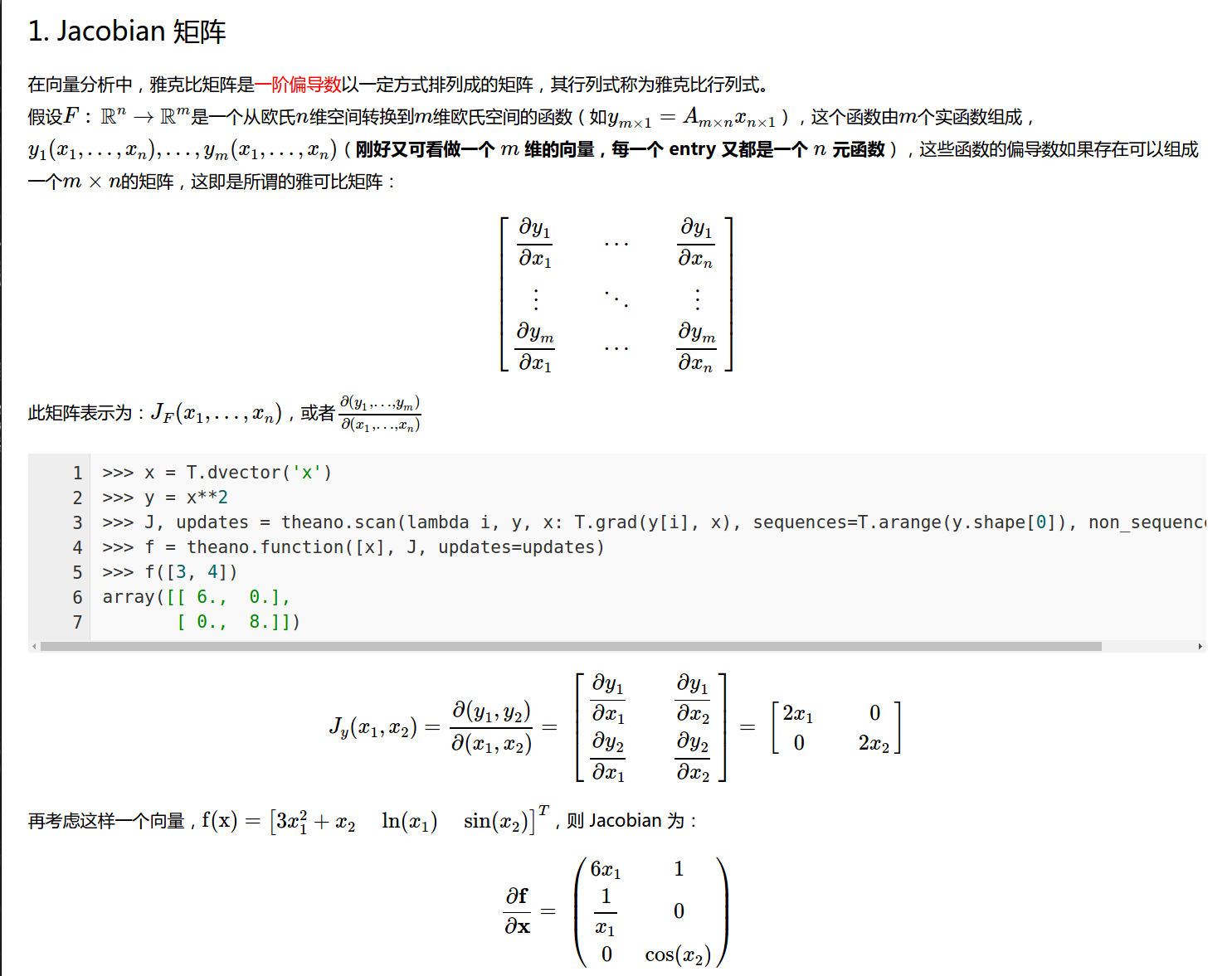
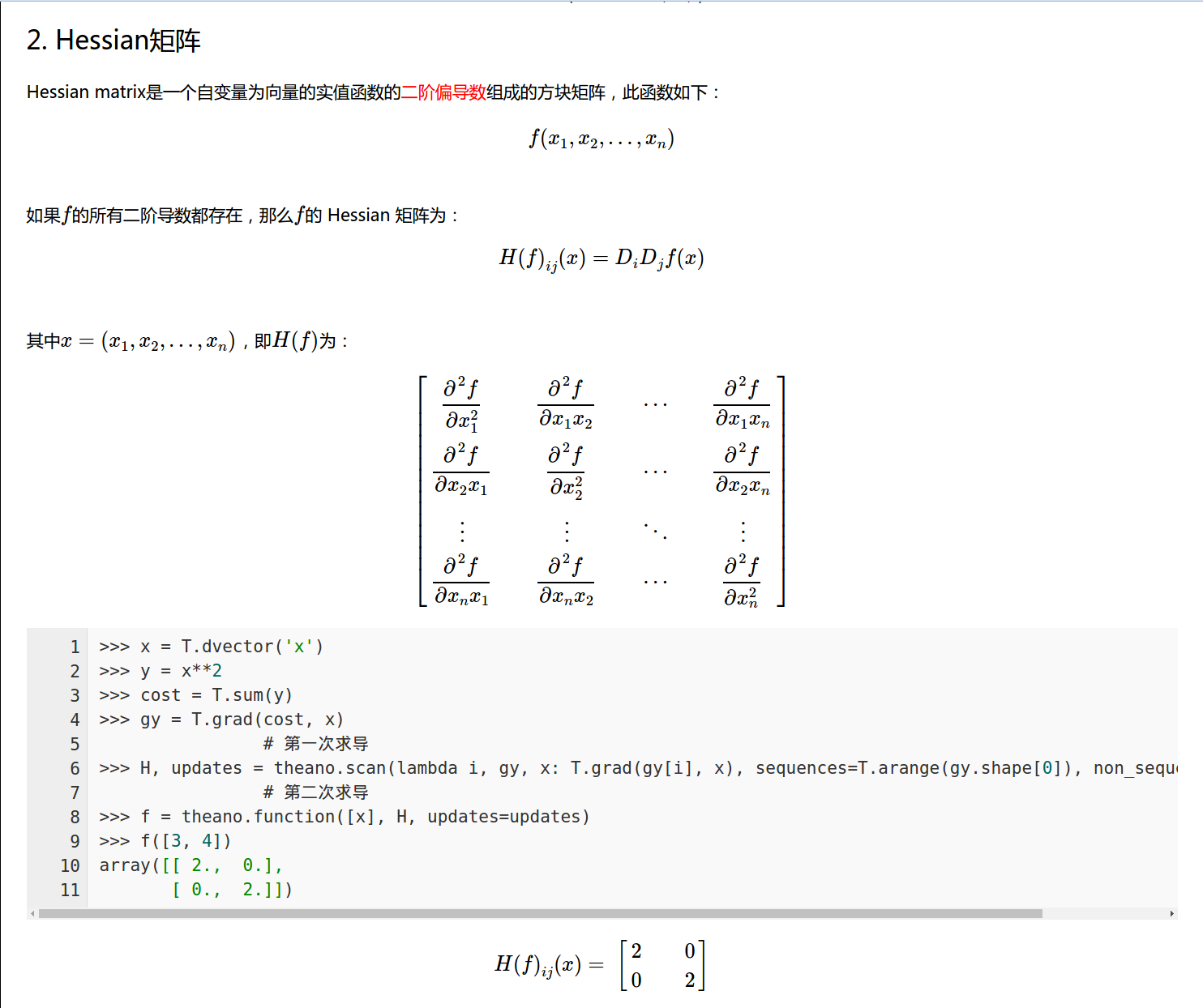
8. set the GPU mode in theano framework:
vim ~/.theanorc
and add these lines into this file:
[global]
device = gpu
floatX=float32
[nvcc]
flags=--machine=64
[lib] cnmem=100
==>> then test these codes to see whether it shown success ?
from theano import function, config, shared, tensor
import numpy
import time vlen = 10 * 30 * 768 # 10 x #cores x # threads per core
iters = 1000 rng = numpy.random.RandomState(22)
x = shared(numpy.asarray(rng.rand(vlen), config.floatX))
f = function([], tensor.exp(x))
print(f.maker.fgraph.toposort())
t0 = time.time()
for i in range(iters):
r = f()
t1 = time.time()
print("Looping %d times took %f seconds" % (iters, t1 - t0))
print("Result is %s" % (r,))
if numpy.any([isinstance(x.op, tensor.Elemwise) and
('Gpu' not in type(x.op).__name__)
for x in f.maker.fgraph.toposort()]):
print('Used the cpu')
else:
print('Used the gpu')

9. No Module named cv2 :
sudo apt-get install Python-OpenCV
otherwise, you can try:
pip install --upgrade setuptools
pip install numpy Matplotlib
pip install opencv-python
10. The following error happened while compiling the node':
mod.cu(305): warning: subscript out of range
mod.cu(313): warning: subscript out of range
mod.cu(317): error: identifier "cudnnSetConvolutionNdDescriptor_v3" is undefined
1 error detected in the compilation of "/tmp/tmpxft_0000053a_00000000-9_mod.cpp1.ii".
['nvcc', '-shared', '-O3', '-arch=sm_61', '-m64', '-Xcompiler', '-fno-math-errno,-Wno-unused-label,-Wno-unused-variable,-Wno-write-strings,--machine=64,-DCUDA_NDARRAY_CUH=c72d035fdf91890f3b36710688069b2e,-DNPY_NO_DEPRECATED_API=NPY_1_7_API_VERSION,-fPIC,-fvisibility=hidden', '-Xlinker', '-rpath,/root/.theano/compiledir_Linux-3.19--generic-x86_64-with-Ubuntu-14.04-trusty-x86_64-2.7.6-64/cuda_ndarray', '-I/usr/local/lib/python2.7/dist-packages/theano/sandbox/cuda', '-I/usr/local/cuda/include', '-I/usr/local/lib/python2.7/dist-packages/numpy/core/include', '-I/usr/include/python2.7', '-I/usr/local/lib/python2.7/dist-packages/theano/gof', '-o', '/root/.theano/compiledir_Linux-3.19--generic-x86_64-with-Ubuntu-14.04-trusty-x86_64-2.7.6-64/tmpOSxzD1/bd1168e6726f16baed8c5f60c7ded9d1.so', 'mod.cu', '-L/usr/lib', '-lcudnn', '-lpython2.7', '-lcudart']
... and
Exception: ('The following error happened while compiling the node', GpuDnnConvDesc{border_mode=(1, 1), subsample=(1, 1), conv_mode='conv', precision='float32'}(MakeVector{dtype='int64'}.0, MakeVector{dtype='int64'}.0), '\n', 'nvcc return status', 2, 'for cmd', 'nvcc -shared -O3 -arch=sm_61 -m64 -Xcompiler -fno-math-errno,-Wno-unused-label,-Wno-unused-variable,-Wno-write-strings,--machine=64,-DCUDA_NDARRAY_CUH=c72d035fdf91890f3b36710688069b2e,-DNPY_NO_DEPRECATED_API=NPY_1_7_API_VERSION,-fPIC,-fvisibility=hidden -Xlinker -rpath,/root/.theano/compiledir_Linux-3.19--generic-x86_64-with-Ubuntu-14.04-trusty-x86_64-2.7.6-64/cuda_ndarray -I/usr/local/lib/python2.7/dist-packages/theano/sandbox/cuda -I/usr/local/cuda/include -I/usr/local/lib/python2.7/dist-packages/numpy/core/include -I/usr/include/python2.7 -I/usr/local/lib/python2.7/dist-packages/theano/gof -o /root/.theano/compiledir_Linux-3.19--generic-x86_64-with-Ubuntu-14.04-trusty-x86_64-2.7.6-64/tmpOSxzD1/bd1168e6726f16baed8c5f60c7ded9d1.so mod.cu -L/usr/lib -lcudnn -lpython2.7 -lcudart', "[GpuDnnConvDesc{border_mode=(1, 1), subsample=(1, 1), conv_mode='conv', precision='float32'}(<TensorType(int64, vector)>, <TensorType(int64, vector)>)]")

the version of theano is not matched with the code. update the theano will be ok.
11. Theano framework shown an error like this:
File "/usr/local/lib/python2.7/dist-packages/enum.py", line 199, in __init__ raise EnumBadKeyError(key)
Need 2 paramers (given 4)
==>> This error is caused when the enum34 module has been installed alongside the old enum module. enum34 is the backport for Python 2.x of the standard enum in Python 3.4. Many packages have started to use it and so it will be installed implicitly while installing another package. enum34 overrides the old enum files and causes this error.
You could remove enum34 and get rid of this error. But since Python 3.x has already adapted a new enum type, it might be wiser to uninstall the old enum and rewrite your code to use enum34. Its syntax is shown in this example. This explnation comes from: https://codeyarns.com/2015/07/16/attributeerror-with-python-enum/
==>> maybe first you need to do is just install: $ sudo pip install enum34
==>> The second main reason is that: you are using pkle file generted not by your current environments, it's also caused by enum, this is a bug !
==>> So, you can re-generate your pkle file and try again. It will be OK.
12. Load pkl file in python:
## Download the mnist dataset if it is not yet available.
url = 'http://deeplearning.net/data/mnist/mnist.pkl.gz'
filename = 'mnist.pkl.gz'
if not os.path.exists(filename):
print("Downloading mnist dataset ... ")
urlretrieve(url, filename)
## we will then load and unpickle the file.
import gzip
with gzip.open(filename, 'rb') as f:
data = pickle_load(f, encoding='latin-1')
13. ValueError: You are tring to use the old GPU back-end. It was removed from Theano. Use device=cuda* now.
wangxiao@AHU-Wangxiao:/media/wangxiao/724eaeef-e688-4b09-9cc9-dfaca44079b2/saliency-salgan-2017-master-tracking/scripts--suntao--finalVersion$ python wangxiao-02-train.py
Traceback (most recent call last):
File "wangxiao-02-train.py", line 11, in <module>
import theano
File "/usr/local/lib/python2.7/dist-packages/theano/__init__.py", line 67, in <module>
from theano.configdefaults import config
File "/usr/local/lib/python2.7/dist-packages/theano/configdefaults.py", line 119, in <module>
in_c_key=False)
File "/usr/local/lib/python2.7/dist-packages/theano/configparser.py", line 285, in AddConfigVar
configparam.__get__(root, type(root), delete_key=True)
File "/usr/local/lib/python2.7/dist-packages/theano/configparser.py", line 333, in __get__
self.__set__(cls, val_str)
File "/usr/local/lib/python2.7/dist-packages/theano/configparser.py", line 344, in __set__
self.val = self.filter(val)
File "/usr/local/lib/python2.7/dist-packages/theano/configdefaults.py", line 98, in filter
'You are tring to use the old GPU back-end. '
ValueError: You are tring to use the old GPU back-end. It was removed from Theano. Use device=cuda* now. See https://github.com/Theano/Theano/wiki/Converting-to-the-new-gpu-back-end%28gpuarray%29 for more information.
==>> just replace your gpu back-end with the suggestions, i.e. device=cuda*
vim ~/.theanorc
and add these lines into this file:
[global]
device = cuda
floatX=float32
[nvcc]
flags=--machine=64
[lib] cnmem=100
14. Can not use cuDNN on context None: cannot compile with cuDNN. We got this error:
wangxiao@wangxiao:/media/wangxiao/724eaeef-e688-4b09-9cc9-dfaca44079b2/saliency-salgan-2017-master-tracking/scripts--suntao--finalVersion$ python wangxiao-02-train.py
Can not use cuDNN on context None: cannot compile with cuDNN. We got this error:
/usr/bin/ld: cannot find -lcudnn
collect2: error: ld returned 1 exit status
==>> vim .theanorc
[global]
device = cuda
floatX = float32
[dnn]
enabled = True
include_path=/usr/local/cuda/include
library_path=/usr/local/cuda/lib64
==>> This will make the cuDNN work.
Using cuDNN version 5110 on context None
Mapped name None to device cuda: GeForce GTX 1080 (0000:02:00.0)
15. theano && Lasagne, ImportError: No module named cuda
Traceback (most recent call last):
File "wangxiao-02-train.py", line 17, in <module>
from models.model_salgan import ModelSALGAN
File "/media/wangxiao/724eaeef-e688-4b09-9cc9-dfaca44079b2/saliency-salgan-2017-master-tracking/scripts--suntao--finalVersion/models/model_salgan.py", line 7, in <module>
import generator
File "/media/wangxiao/724eaeef-e688-4b09-9cc9-dfaca44079b2/saliency-salgan-2017-master-tracking/scripts--suntao--finalVersion/models/generator.py", line 11, in <module>
import C3D_AlexNet
File "/media/wangxiao/724eaeef-e688-4b09-9cc9-dfaca44079b2/saliency-salgan-2017-master-tracking/scripts--suntao--finalVersion/models/C3D_AlexNet.py", line 14, in <module>
from lasagne.layers.dnn import Conv3DDNNLayer, MaxPool3DDNNLayer
File "/usr/local/lib/python2.7/dist-packages/lasagne/layers/dnn.py", line 2, in <module>
from theano.sandbox.cuda import dnn
ImportError: No module named cuda
==>> change the following codes:
export LD_LIBRARY_PATH=/home/wangxiao/cuda-v5.1/lib64:$LD_LIBRARY_PATH
export CPATH=/home/wangxiao/cuda-v5.1/include:$CPATH
export LIBRARY_PATH=/home/wangxiao/cuda-v5.1/lib64:$LIBRARY_PATH
16. Error: pygpu.gpuarray.GpuArrayException: out of memory
0%| | 0/301 [00:00<?, ?it/s]Traceback (most recent call last):
File "wangxiao-02-train.py", line 231, in <module>
train()
File "wangxiao-02-train.py", line 217, in train
salgan_batch_iterator(model, train_data, None)
File "wangxiao-02-train.py", line 148, in salgan_batch_iterator
G_obj, D_obj, G_cost = model.G_trainFunction(batch_input,batch_output,batch_patch)
File "/home/wangxiao/anaconda2/lib/python2.7/site-packages/theano/compile/function_module.py", line 898, in __call__
storage_map=getattr(self.fn, 'storage_map', None))
File "/home/wangxiao/anaconda2/lib/python2.7/site-packages/theano/gof/link.py", line 325, in raise_with_op
reraise(exc_type, exc_value, exc_trace)
File "/home/wangxiao/anaconda2/lib/python2.7/site-packages/theano/compile/function_module.py", line 884, in __call__
self.fn() if output_subset is None else\
File "pygpu/gpuarray.pyx", line 654, in pygpu.gpuarray.pygpu_empty (pygpu/gpuarray.c:9764)
File "pygpu/gpuarray.pyx", line 280, in pygpu.gpuarray.array_empty (pygpu/gpuarray.c:5616)
pygpu.gpuarray.GpuArrayException: out of memory
Apply node that caused the error: GpuAllocEmpty{dtype='float32', context_name=None}(Assert{msg='The convolution would produce an invalid shape (dim[0] < 0).'}.0, Assert{msg='The convolution would produce an invalid shape (dim[1] < 0).'}.0, Assert{msg='The convolution would produce an invalid shape (dim[2] <= 0).'}.0, Assert{msg='The convolution would produce an invalid shape (dim[3] <= 0).'}.0)
Toposort index: 1310
Inputs types: [TensorType(int64, scalar), TensorType(int64, scalar), TensorType(int64, scalar), TensorType(int64, scalar)]
Inputs shapes: [(), (), (), ()]
Inputs strides: [(), (), (), ()]
Inputs values: [array(30), array(256), array(56), array(56)]
Outputs clients: [[GpuDnnConv{algo='small', inplace=True}(GpuContiguous.0, GpuContiguous.0, GpuAllocEmpty{dtype='float32', context_name=None}.0, GpuDnnConvDesc{border_mode=(1, 1), subsample=(1, 1), conv_mode='conv', precision='float32'}.0, Constant{1.0}, Constant{0.0})]]
HINT: Re-running with most Theano optimization disabled could give you a back-trace of when this node was created. This can be done with by setting the Theano flag 'optimizer=fast_compile'. If that does not work, Theano optimizations can be disabled with 'optimizer=None'.
HINT: Use the Theano flag 'exception_verbosity=high' for a debugprint and storage map footprint of this apply node.
==>> THEANO_FLAGS="device=gpu0,floatX=float32" python test.py
==>> THEANO_FLAGS="device=gpu0,floatX=float32,optimizer=None" python test.py
比较有用的信息是:Input dimension mis-match,但是具体出问题在哪里,仍然让人一头雾水。因为Theano的计算图进行了一些优化,导致出错的时候难以与原始代码对应起来。想解决这个也很简单,就是关闭计算图的优化功能。可以通过THEANO_FLAGS的optimizer,它的默认值是”fast_run”,代表最大程度的优化,我们平时一般就使用这个,但是如果想让调试信息更详细,我们就需要关闭一部分优化:fast_compile或者关闭全部优化:None,这里我们将optimizer设置成”None”,执行如下命令:
THEANO_FLAGS="device=gpu0,floatX=float32,optimizer=None" python test.py reference: http://www.qingpingshan.com/bc/jsp/198194.html
17. When import theano, it shown the error:

>>> import theano
Using cuDNN version 5110 on context None
Mapped name None to device cuda: GeForce GTX 1080 (0000:02:00.0)
>>>
==>> Solution:
But when I try the example code in Lasagne: mnist.py, it indeed could run ......
Does it really concern ?
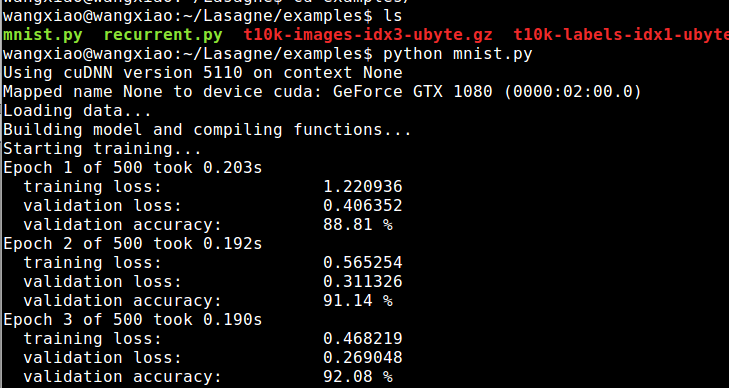
18. one problem occured today, when I import keras using tensorflow backend and pytorch. as followings:
Could not parse default value '20' from Attr("lower_frequency_limit: float = 20") for Op Mfcc
==>> try import keras first, then import pytorch. I solved this issue with this method. TT ...
Summary on deep learning framework --- Theano && Lasagne的更多相关文章
- Summary on deep learning framework --- PyTorch
Summary on deep learning framework --- PyTorch Updated on 2018-07-22 21:25:42 import osos.environ[ ...
- Summary on deep learning framework --- TensorFlow
Summary on deep learning framework --- TensorFlow Updated on 2018-07-22 21:28:11 1. Check failed: s ...
- Summary on deep learning framework --- Torch7
Summary on deep learning framework --- Torch7 2018-07-22 21:30:28 1. 尝试第一个 CNN 的 torch版本, 代码如下: -- ...
- Deep Learning framework --- MexNet 安装,测试,以及相关问题总结
Deep Learning framework --- MexNet 安装,测试,以及相关问题总结 一.安装: 参考博文:http://www.open-open.com/lib/view/op ...
- Install and Compile MatConvNet: CNNs for MATLAB --- Deep Learning framework
Install and Compile MatConvNet: CNNs for MATLAB --- Deep Learning framework 2017-04-18 10:19:35 If ...
- deep learning framework(不同的深度学习框架)
常用的deep learning frameworks 基本转自:http://www.codeceo.com/article/10-open-source-framework.html 1. Caf ...
- Deep learning with Theano 官方中文教程(翻译)(四)—— 卷积神经网络(CNN)
供大家相互交流和学习,本人水平有限,若有各种大小错误,还请巨牛大牛小牛微牛们立马拍砖,这样才能共同进步!若引用译文请注明出处http://www.cnblogs.com/charleshuang/. ...
- Deep learning with Theano 官方中文教程(翻译)(三)——多层感知机(MLP)
关于更多的http://deeplearning.net/tutorial/的翻译还有学习笔记会陆续整理传到博客. 供大家相互交流和学习,本人水平有限,若有各种大小错误,还请巨牛大牛小牛微牛们立马拍砖 ...
- Machine and Deep Learning with Python
Machine and Deep Learning with Python Education Tutorials and courses Supervised learning superstiti ...
随机推荐
- es5原型式继承间解
1. 原型式继承方法 js 继承使用不难,要说清楚,需要自己一定总结,才能说清楚. es5 的继承方式有很多种,这个是 js 语言本身造成,但是类实现继承之后的功能,有如下 3 条: 子类继承父类,主 ...
- ACC(Attribute Component Capability) 即特质,组件,能力
这是一种测试计划的替代方法. ACC的指导原则如下: 1. 避免散漫的文字,推荐使用简明的列表.并不是所有的测试人员都想当小说家,也不具备将一个产品的目标或测试需求表达成散文的技能. 2.不必推销.测 ...
- 快递单号自动识别接口API-trackingmore
一.快递单号自动识别接口功能说明 (1)PC电脑端.移动APP或者自建网站集成物流查询功能时,只需要用户输入单号即可,不需要输入快递公司. (2)此接口可以配合Trackingmore的快递查询API ...
- jenkins 判断某个job是否正在构建
其实很简单,访问jenkins job的xml api或者 json api,里面有两个key叫"lastBuild"和"lastCompletedBuild" ...
- charles-Andriod 手机手机抓包乱码
然后重启进行进行抓包
- Android Studio旧版(内含SDK)安装和环境变量配置 转自I-T枭
win10下Android Studio和SDK下载.安装和环境变量配置 ------made by siwuxie095 转自I-T枭https://me.csdn.net/hahahhahahah ...
- 微软移除WIN10密码过期政策Microsoft Removes Password-Expiration Policy in Windows 10
Microsoft this week announced a series of changes to the security baseline in Windows 10, including ...
- FB面经 Prepare: Even Tree
You are given a tree (a simple connected graph with no cycles). The tree has nodes numbered from to ...
- SecureCRT通过密钥登录(网上也有很多教程,但是有些不详细,此教程本人亲测)
1.先打开SecureCRT,标题标--工具---创建公钥,如图: 2.点击创建公钥,弹出选项点下一步 3.继续点下一步: 4.继续点下一步: 5.继续点下一步(密钥长度默认1024即可),生成密钥需 ...
- py001
pip install requests -i https://pypi.tuna.tsinghua.edu.cn/simple -------------------------------- ...
